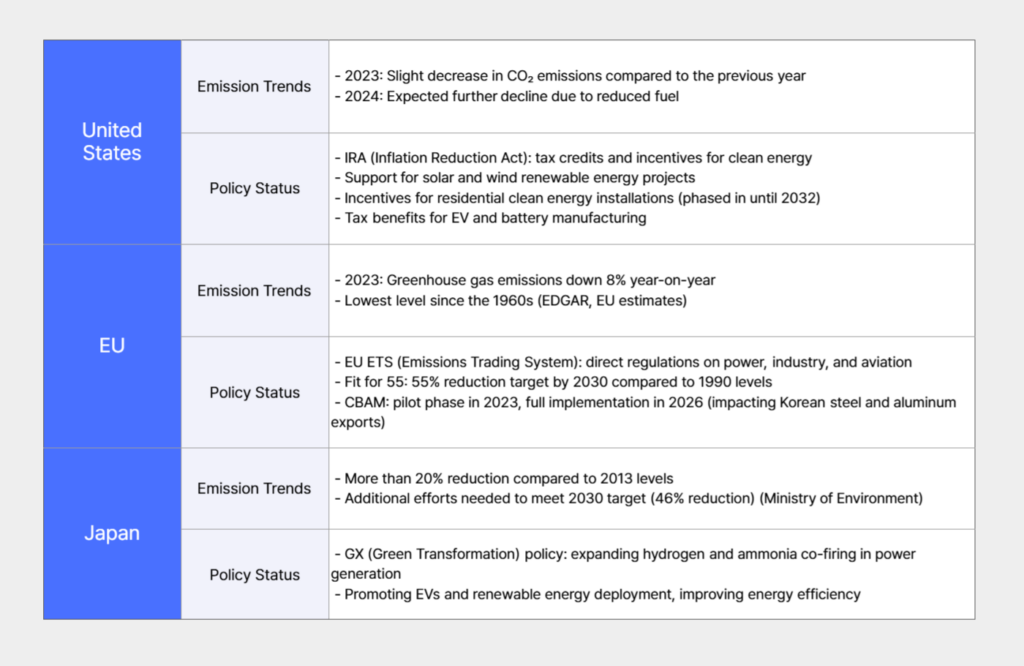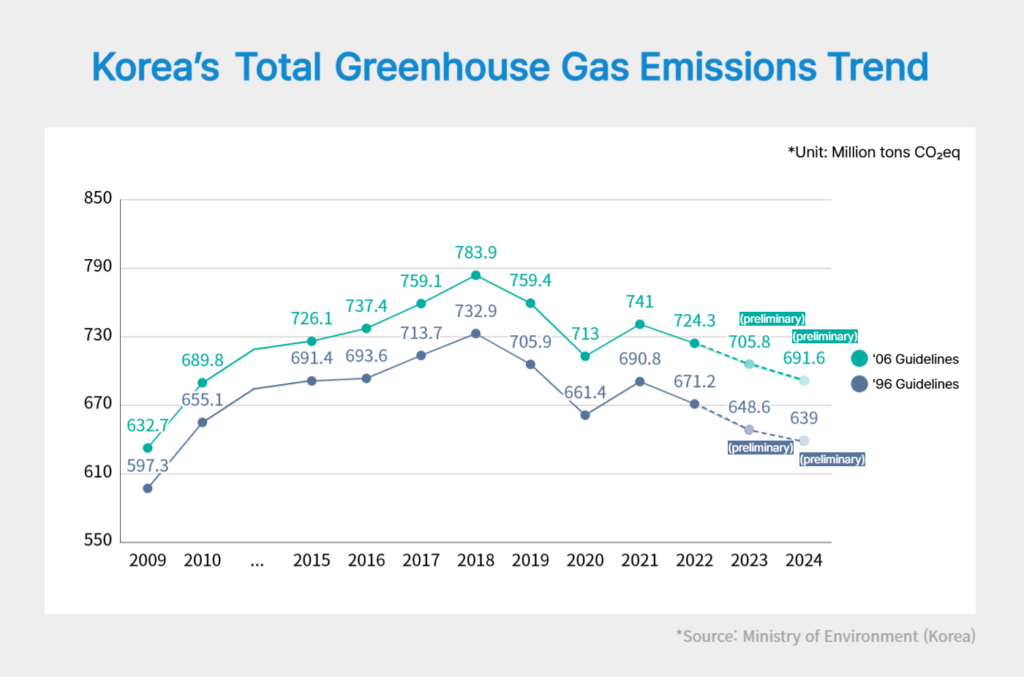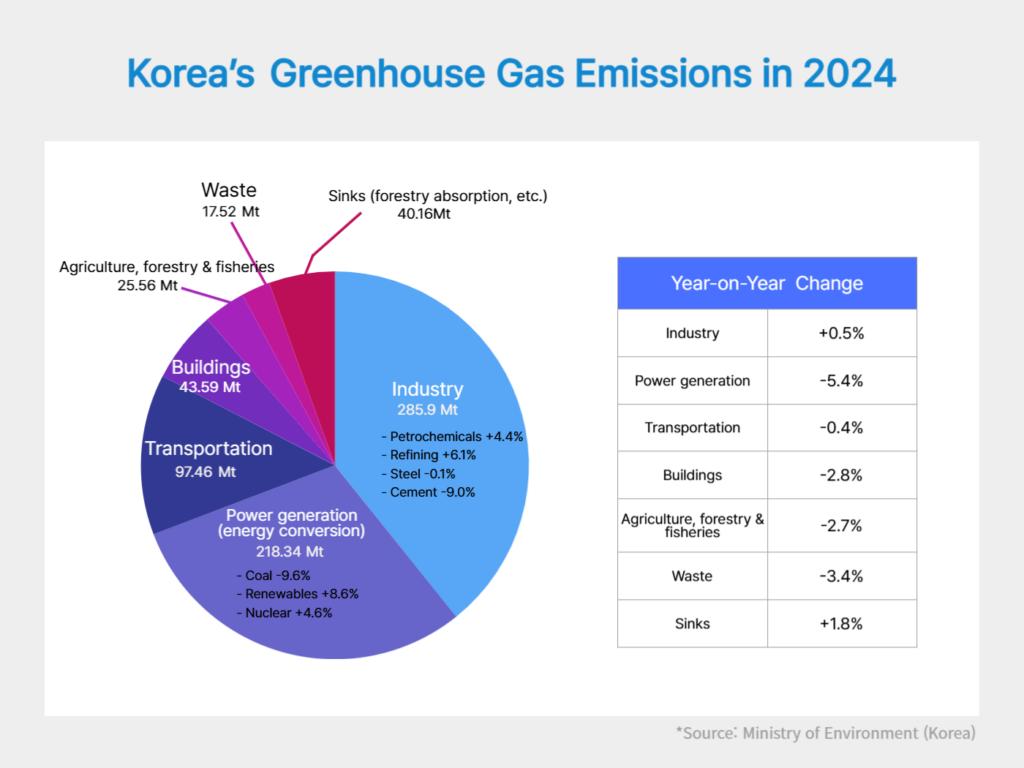Warnings of the Heatwave Era and the Challenge of Greenhouse Gas Management
2025.09.29
🔍 The climate disasters humanity faces today underscore the urgent need for greenhouse gas management. Through the Kyoto Protocol and the Paris Agreement, the international community institutionalized emission reductions, and countries such as the United States, the EU, and Japan have actively advanced policies tailored to their national contexts. In Korea, the Ministry of Environment announced that the nation’s preliminary greenhouse gas emissions in 2024 fell slightly compared to the previous year, but the reduction remains heavily dependent on the power sector. To drive a genuine transition in industry and transportation, catalyst technology is becoming increasingly critical, and Heesung Catalysts is presenting diverse solutions in this field.

“One out of every four heatwaves would not have occurred at all without human-induced greenhouse gas emissions.”
A recent international research team, including ETH Zurich and the University of Oxford, analyzed 23 years of global disaster data from 2000 using the International Disaster Database. The study found that cumulative greenhouse gas emissions from fossil fuels and the cement industry accounted for 57% of the total.
According to the research, the frequency of heatwaves linked to climate change increased twentyfold between 2000–2009 compared to 1850–1900, and two hundredfold between 2010–2019. Their intensity also rose: 1.4°C higher in 2000–2009, 1.7°C higher in 2010–2019, and 2.2°C higher in 2020–2023 compared to pre-industrial levels.
The team further examined emissions from 180 major carbon-intensive companies and found that these firms were responsible for over 50% of the increase in heatwave intensity since 1850–1900. This equates to having contributed directly or indirectly to at least 16 and up to 53 extreme heat events.
These findings reaffirm how strongly human activities influence climate disasters, highlighting the necessity of greenhouse gas management.
International Actions on Emissions
The global community has been proactive in its response to the climate crisis. The Kyoto Protocol of 1997 introduced legally binding obligations for developed countries, while the Paris Agreement of 2015 marked the first universal climate accord, joined by nearly every nation. More recently, policies such as the EU’s Carbon Border Adjustment Mechanism (CBAM), the U.S. Inflation Reduction Act (IRA), and Japan’s GX policy underscore that greenhouse gas management is not just an environmental issue—it is directly tied to trade, investment, and industrial competitiveness.
- 1997 Kyoto Protocol: The first treaty to impose legally binding emission reduction obligations on developed countries, institutionalizing national-level management.
- 2015 Paris Agreement: The first universal climate agreement aimed at limiting global warming to well below 2°C, ideally 1.5°C. Nations are required to submit Nationally Determined Contributions (NDCs) and regularly report and verify progress.
- Recent regulatory tightening: The EU’s CBAM, the U.S. IRA, and Japan’s GX policy demonstrate that emission reductions are a matter of global market survival as much as environmental responsibility.
Why Greenhouse Gas Management Matters
Greenhouse gas management is more than fulfilling international obligations—it is a direct factor in industrial competitiveness, socio-economic stability, and corporate sustainability.
(1) Fulfilling international commitments
Achieving national targets under the Paris Agreement requires strict emissions management. Performance in this area affects a country’s global credibility.
(2) Securing industrial competitiveness
Trade mechanisms like CBAM directly affect export-oriented economies like Korea’s. Cutting emissions is not only about compliance but also about maintaining global competitiveness.
(3) Ensuring economic and social stability
Energy transition and renewable expansion create long-term stability. Managing emissions reduces the social and economic costs of climate disasters.
(4) Strengthening ESG management
Global investors and consumers increasingly prefer companies with strong ESG performance. Reducing emissions directly enhances corporate sustainability, brand value, and market appeal.
How Major Economies Are Responding
With international norms in place, countries are pursuing policies suited to their domestic contexts to meet reduction goals.

Korea’s 2024 Greenhouse Gas Inventory
The Ministry of Environment and the Greenhouse Gas Inventory & Research Center of Korea announced in January 2025 that Korea’s preliminary emissions for 2024 were 691.58 million tons CO₂eq—down 2% year-on-year. This marks a reduction of 14.19 million tons from the previous year based on 2006 IPCC guidelines, or 9.63 million tons based on 1996 guidelines. Compared with 2018, the NDC base year, the figure is 93.89 million tons lower.


Despite this modest reduction, most progress came from cutting coal use and expanding nuclear and renewables in the power sector. To meet the 2030 NDC target—a 40% reduction from 2018 levels—Korea must cut an additional 200 million tons, averaging 3.6% annually. Industry and transport remain the slowest to decarbonize, requiring both efficiency gains and technological innovation.
Catalysts as Enablers of Carbon Neutrality
While power sector progress is notable, emissions in industry and transportation remain high, and structural reduction has been delayed. Catalyst technologies hold the key to meaningful transformation across these sectors.
(1) Industrial processes in refining, petrochemicals, and steel
Enhancing catalyst efficiency reduces raw material consumption and cuts CO₂ emissions directly. In high-temperature processes like cement and steelmaking, catalyst-based NOx removal and oxidation technologies reduce both pollutants and greenhouse gases.
(2) Automotive emissions reduction and future fuels
Automotive catalysts mitigate NOx, CO, and hydrocarbons, indirectly lowering greenhouse gas impact. In addition, catalyst applications extend to hydrogen ICEs and ammonia-fueled engines, supporting next-generation low-carbon mobility.
(3) Abatement of high-GWP gases (N₂O, CH₄)
Industrial processes and waste management emit nitrous oxide and methane, potent greenhouse gases. N₂O decomposition and methane oxidation catalysts provide effective means of reducing these emissions.
(4) Catalysts for hydrogen, ammonia, and SAF
In the energy transition, catalysts play indispensable roles in hydrogen production, ammonia cracking, fuel cell electrodes, and sustainable aviation fuel (SAF) production, strengthening the foundation for a carbon-neutral energy system.
It is time to move from awareness to action on carbon neutrality, and catalysts offer one of the most practical and effective solutions
Greenhouse gas reduction is both a shared international mission and a matter of national survival. Korea cannot rely solely on progress in the power sector; industry and transport must also undergo structural transformation. Catalyst technologies provide concrete pathways—improving process efficiency, enabling future fuels, mitigating high-GWP gases, and supporting clean energy transitions. Through continued innovation, Heesung Catalysts is committed to supporting decarbonization across industry and transport, contributing to Korea’s 2030 emission reduction goals and the global pursuit of carbon neutrality.
💡 Related Reads
🔗 Greenhouse Gas Reduction Catalysts


